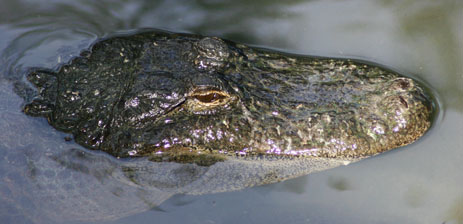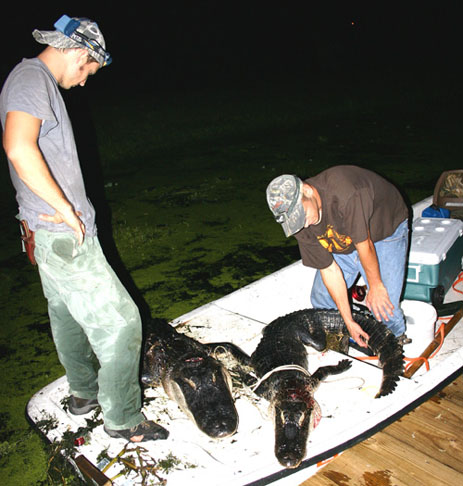 |
|||||||||||
|
|||||||||||
|
Photo Fiona Sunquist © Humans and alligators have shared the lakes and marshes of Florida for many centuries. Native Indians occasionally hunted gators for food, but it was not until the Industrial Revolution in Europe that the fashion industry began producing alligator skin products. Leather made from alligator belly skin was in great demand for boots, shoes, travel bags, saddlebags, purses, card cases, and belts. Commercial hunting of alligators reached a peak after the American Civil War, and huge numbers of alligators were killed in a short time. In 1888, in the Cocoa Beach area of Florida, ten hunters killed 5000 alligators in a single season. At this time it was commonplace for each alligator hunter to kill 200 to 400 animals per year. By the early 1900s most alligator skins were being used for boots and shoes, ladies handbags and belts. Demand for skins increased as supplies dwindled. Florida records show that while 190,000 skins were traded in 1929, the number fell to 120,000 in 1934, and continued to decrease until 1943, when only 6800 skins were traded. A century of unrestricted hunting had depleted the seemingly inexhaustible supply of these prehistoric looking reptiles. In 1944 Florida introduced legislation to protect alligators during the breeding season and prohibiting the killing of alligators less than 4 feet (1.2 m) in length. But populations continued to decline, and it was not until 1970, when federal laws prohibited the interstate shipment of alligators, that protective measures finally began to take effect. With protection alligators began to repopulate areas where they had once been hunted almost to extinction. In 1979 the species was downgraded from IUCN listing, but the CITES Appendix II classification remains in place to help control the trade in ‘look-a-like’ crocodilian species. A rapidly increasing human population has led to an increase in the number of complaints about alligators in back yards, swimming pools, golf course water hazards, and other places where they are not wanted. The Fish and Wildlife Conservation Commission receives more than 10,000 alligator related complaints each year. Despite the high degree of human-alligator contact, only 20 people have been killed by alligators in Florida since the Florida Fish and Wildlife Conservation Commission began keeping records in 1948. Most people who call in a ‘nuisance’ alligator think that the animal will simply be moved to a remote area. This is only partly true. Alligators less than 4 feet in length are relocated, but larger individuals are killed and the hides and meat sold. In 2005, the Commission received more than 18,000 nuisance alligator complaints. Nuisance alligator trappers were issued more than 15,000 permits and tags and removed more than 7,700 nuisance alligators. The gross value of nuisance alligator hides and meat produced in 2001 was approximately $2.3 million. There are about 40 professional alligator hunters in Florida, most of them trap ‘nuisance’ alligators for the state. These licensed trappers are self-employed and make a living by selling the skins and meat. The market for skins is highly variable from year to year; but in 2006 the market was up almost 50% from 2002, hides now bring $50 per foot. Alligator meat is sold to restaurants and wholesalers, and brings $5 to 7 a pound. With protection, alligator numbers rebounded so successfully that state wildlife authorities began an experimental hunting program in 1981, and in 1988 controlled hunting was allowed throughout much of Florida. Today, professional trappers and hunters, and thrill-seeking members of the general public can apply to harvest a limited number of alligators each year. Applications must be made to the office of the Florida Fish and Wildlife Conservation Commission by June 15 each year. Up to 4,000 applicants are randomly selected from the thousands that apply. Each participant is allowed to take two alligators that are more than 4 feet long. Applicants must complete a training and orientation program. Applicants also have to purchase an alligator-trapping license, which costs $272 for a resident and $1,022 for a non-resident. A three-night-hunting trip with a professional guide, lodging, meals, transportation, and with luck, a gator costs more than $3,500 per hunter. Private landowners are allowed to harvest 100 alligators a year, if they preserve at least 1000 acres of wetland.
Photo Fiona Sunquist ©
|
| • Live weather radar • About Florida weather • Map & Key to Regions |

Wildlife of Florida 2011
Fiona Sunquist
Download $19.99


Wildlife of Florida: Lizards
Fiona Sunquist
Download $2.49

gator/crocs | birds | mammals | snakes | turtles | frogs/toads | lizards | sharks
Wildlife | Favorite Activities | My Destinations | about us | resources | site map | home
![]() web site development by Creative Communications
web site development by Creative Communications













